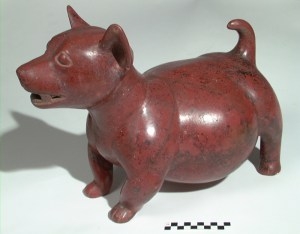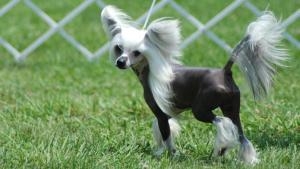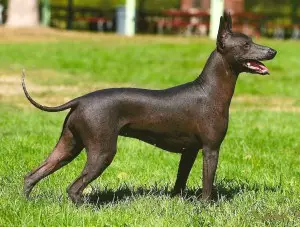Chihuahua History
The full story
Techichi Origin
As for most dog breeds, the origins of the Chihuahua is somewhat unclear. You can find a number of wild theories that are being suggested on a number of websites. However, we focus on what is scientifically proven. In 2013 the Institute of Technology in Stockholm released their findings regarding the ancestry of dog breeds. They used a phylogeographic analysis which traces back the origin of the mitochondrial DNA lineages for Greenland dogs, Alaskan Malamute but also the Chihuahua. In other words, the researchers compared DNA from current dog breeds with archaeological samples from certain ancient dog breeds. Following their research, they found that a maximum of 30% of the DNA of the Chihuahua could be traced back to non-American dog breeds. Furthermore, the majority of the DNA of the Chihuahua was shared with South American samples. These South American samples can be traced back to an ancient dog breed called the Techichi.
In order to explain the phylogeographic analysis, we refer to the schematic below. Imagine that the Techichi is represented by 2 yellow bars and 2 green bars. The ancestors of the Techichi are represented above by two animals (one with 4 yellow bars and one with 4 green bars). The Chihuahua is best represented by the combination of 2 yellow bars, 1 green bar and 1 orange bar. What we know for sure is that roughly 70% of the DNA of the Chihuahua comes from an ancient South American dog breed (most likely the Techichi). The other 30% is represented by the orange bar. The orange bar comes from a completely different dog that cannot be traced back to any dog breed that was present in Mexico in pre-Columbian times.

South American ancestors

The Techichi was a small South American dog that was bred by the Toltec civilization. During the Mesoamerican period (900-1168 CE.) the Toltec culture dominated a state centered in Tula, Hidalgo, Mexico. The Toltec are regarded to be a great and prosperous civilization and were seen by the Aztecs as their cultural predecessors. The first scientific article about the Toltec was written by Daniel Garrison Brinton in 1887. His article “Were the Toltecs a Historic Nationality?” appeared in the proceedings of the American Philosophical Society (page 229-241).
The Techichi was bred by the Toltec for hunting purposes and for companionship. Additionally, they also believed that the Techichi possessed a number of supernatural powers such as seeing into the future. Consequently, they were often sacrificed so they could guide their deceased owner in the underworld. Furthermore, several artefacts were found which further show the resemblance and genetic connection of Techichi and the chihuahua we know today.

Chihuahua relics
Wheeled dog toys that were found at Tres Zapotes in Veracruz, Mexico dating back to 100 AD. These toys are believed to depict both apple head and deer head varieties of the Techichi.

Effigy pots and sculptures were found in ancient burial shafts in Colima, Mexico dating back to 300 BC. These pots and sculptures depict a dog strikingly similar to the current day Chihuahua.

Drawings found in the ruins of Chichen Itza on the Yucatan Peninsula that date back to the 5th century AD. Please note the deer-like antlers on the deer shaped head on the drawing.

UNKNOWN ANCESTOR
A study conducted in 2013 by the University of Technology in Sweden found that 30% of the DNA of the Chihuahua comes from a dog breed outside of Mexico.
Chinese Crested
A possible candidate is a small hairless dog breed from China similar to the breed currently known as the Chinese Crested. It is thought that they were brought to Mexico by the conquistadores in the 16th century. Furthermore, the Chinese Crested was already imported into Europe via the Silk Road (120 BC – 1450 CE). Spanish traders could have potentially brought this dog with them to Mexico. The Chinese Crested would then have been crossbred with the Techichi by the Spanish and brought back to Europe as a gift for their family.

Xoloitzcuintli
Another possibility is that the Swedish study was not able to obtain samples of the Xoloitzcuintli or Xolo that is native to Mexico. If these samples were included in their phylogeographic analysis it is possible that the remaining 30% of the DNA can be traced back to the Xolo.

Maltese pocket dog
The last possible ancestor we will discuss is the Maltese pocket dog. The Maltese pocket dog has a European origin and shares a unique feature with the Chihuahua. It has a molera in its skull, which is an opening in the top of the skull. It is possible that the conquistadors brought the dog over to Mexico in order to crossbreed. However, it is more likely that they share this unique feature due to the fact that they are both very small dog breeds.

Summary
We currently know that the Chihuahua we know today derives its name from the Mexican State Chihuahua. The capital of the state Chihua is Chihuahua City, located in Northwestern Mexico. The city was founded in 1709 by Spanish explorer Blas Cano de los Rios. The dog effigy pots that were found here are undeniable proof that a small dog breed with very similar characteristics as the Chihuahua was bred here. Additionally, the ancestor of the Chihuahua we know today is almost certainly the Techichi. However, there is still a part of the DNA (+- 30%) of the Chihuahua for which the origin remains unclear.
Recent Chihuahua History
First Chihuahua
The first Chihuahua officially recognized by the American Kennel Club (AKC) was named Midget. He was born on July 18, 1903 on a ranch in Texas. His owner H. Raynor Midget registered him in 1904 making the Chihuahua one of the first registered dog breeds in America. One of the first famous actresses to own a Chihuahua is Lupe Velez.

Urbanisation
It took many decades for the Chihuahua to become popular in the United States despite being one of the olders dog breeds. The majority of the people in the 20th century bred dogs out of utilitarian purposes (such as hunting, guarding and herding). The Chihuahua was simply to small to be of any use on a farm. However, during the 1960s there was a massive urbanization in the U.S. due to rapid industrialization. By the end of the sixties two out of three Americans lived in urban areas compared to one out of four in 1870. Due to its smaller size and lower energy level, the Chihuahua was the ideal dog for city life. By 1964 the popularity of the Chihuahua soared and became the 12th most popular dog breed in the United States (31st worldwide).
